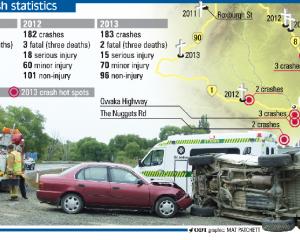Every road fatality is a tragedy, and every death impacts on a large number of people.
National road policing manager Superintendent Paula Rose is of the view that each victim of a vehicle accident "touches about 500 people".
Last year, 375 people died on the roads: that amounts to 187,500 people affected.
Personal and familial loss are the first and most immediate consequences. Then there are the adverse flow-on effects such traumas can impart on families and relationships.
Grief can tear families apart and, in the aftermath of terrible accidents, blame and guilt also play their part in the unfolding emotional turmoil.
Often forgotten in the perennial accounting exercise are the large numbers of people severely injured and, in some cases, maimed for life as a result.
The chain of repercussions moves on down to the terrible waste of human potential, and the cost in terms of rescue resources - ambulances, helicopters, trauma specialists - in the immediate wake of the accident; and of health service and ACC contributions to treatment and rehabilitation of the injured in the longer term.
Road accidents and the road toll itself are an avoidable and unnecessary blight on society, and at this time of year, as families gather and people celebrate the festive season, it darkens the lives of far too many.
This year the holiday road toll, which is measured from 4pm on December 23 until 6am today, had yesterday reached 17.
This exceeds the tally of 12 in 2010 but is still significantly fewer than the 25 deaths recorded for the 2009 holiday season.
However, as any grieving family member, relative or friend will inform, the preoccupation with the bare numbers masks the individual tragedy that each fatality represents.
But if it is possible to talk of "good news" in the same breath as "road toll", then this comes in the observation that, overall, it is trending sharply down.
The road toll for 2011 is 284. That is 284 too many but compares favourably with 375 deaths last year and is the lowest annual toll since 1952 - the last year in which fewer than 300 people were killed in vehicle crashes.
The 375 in 2010 was also a significant reduction on previous years.
This is a vast improvement since the toll peaked with 843 deaths in 1973 - a figure which set in train the first drink-drive blitzes and led to anti-speeding and "belt-up" campaigns.
It demonstrates that the concerted campaigns mounted by the police and Land Transport New Zealand are beginning to take effect.
High among the determining factors is likely to be the increasing awareness of the need to behave safely on the roads.
The introduction of the zero drink-drive limit for road-users under 20 has further reinforced the message among the young that alcohol and driving do not mix.
To be fair to this age group, much of it has come into a driving culture imbued with a "designated-driver" impulse, which is not necessarily the case with the young drivers of 30 and 40 years ago who thought nothing of getting behind the wheel of a car after a night at the pub.
Some of those people still show up among the recidivist drink-driving convictions in the courts, and there are sufficient deaths and accidents involving drivers under 25 to know that the message has not got home to all the young.
That it has evidently registered with increasing numbers of younger drivers is in no small part due to the creative advertising campaigns that have peppered our screens and billboards.
The recent "ghost chips" television commercial featuring a young man talking his intoxicated friend out of driving has had a particular impact.
So have lowering the speeding tolerance levels with the associated publicity campaigns. "Speed Kills" remains a potent, and accurate, warning for motorists.
Additionally, tough economic times may have had an effect by reducing numbers on the road, particularly those driving for "fun" whose frivolity might often entail unsafe antics.
And while considerable progress has been made in reducing the national road toll, there are still sectors, including rural driving, in which improvement remains stubbornly elusive as we move into 2012.






